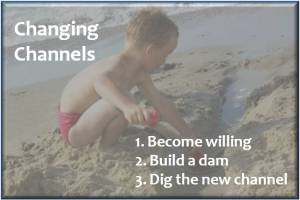 There is an old adage which has been quoted by President Ezra Taft Benson, among others: “It is better to prepare and prevent than to repair and repent.” This applies to living in a state of recovery as much (if not more) than it does to everyday life.
There is an old adage which has been quoted by President Ezra Taft Benson, among others: “It is better to prepare and prevent than to repair and repent.” This applies to living in a state of recovery as much (if not more) than it does to everyday life.
Think of it like this. My normal walk through life is like wading in the surf. The gentle ocean waves come in and out, lapping against my calves as I look around at the scenery and keep my eyes open for beautiful shells on the beach. Perhaps I walk out to a sandbar to see what I can find there. When the tide comes in the water rises. It can get up to my waist, with waves going even higher. If I don’t stay aware of the both the tide and the waves, I may find myself sputtering for air if I get hit by a particularly large one. However, if I keep aware and alert, I will see the wave coming. I can prepare by jumping up at the right moment, to keep my head above the water. Or, even better, I can get myself to safety before the tide gets that high. The more I practice this kind of awareness, the better I will become at recognizing how to keep myself safe.
How to Prepare for Everyday Life
One of the questions I ask my sponsees when we talk is, “What might happen today that could blindside you?” Then I ask, “What can you do to prepare so that you don’t lose your abstinence (or composure) when something unexpected happens?”
For example, if a compulsive eater tells me that she will be going with a group to a restaurant, I may encourage her to find the menu online and decide what she is going to eat before she gets there. Deciding what to order when you are hungry and surrounded by people who are ordering things which might not be good choices for you (but sound yummy) may not be a good idea.
Here is another example. A sponsee told me that she was going to have a very busy afternoon and evening, with just enough time to come home and eat before they were off to the evening’s activities. I asked her what she was planning to make for dinner. She hadn’t thought about it. She realized during our conversation that if she didn’t plan ahead and put something in the slow cooker in the morning, the options available in the evening were not going to be good, and she would be stressed and rushed. That is not a good situation to be in when you are trying to recover from any addiction. Knowing that dinner would be ready when they walked in the door contributed to their family having a much less stressful afternoon and evening.
- Have you ever found yourself blindsided by something that you could have avoided if you had thought ahead about it?
- Are you willing to practice thinking through your day and planning in the morning so that the rest of your day will go well?
- What will you do today to avoid the “high tides” of life and prepare for the waves?
Please share your thoughts about this post by commenting below.
Related Posts: Planned Abstinence, Some Patterns Cause Us to Stumble, Others Help Us Build, Changing Channels







